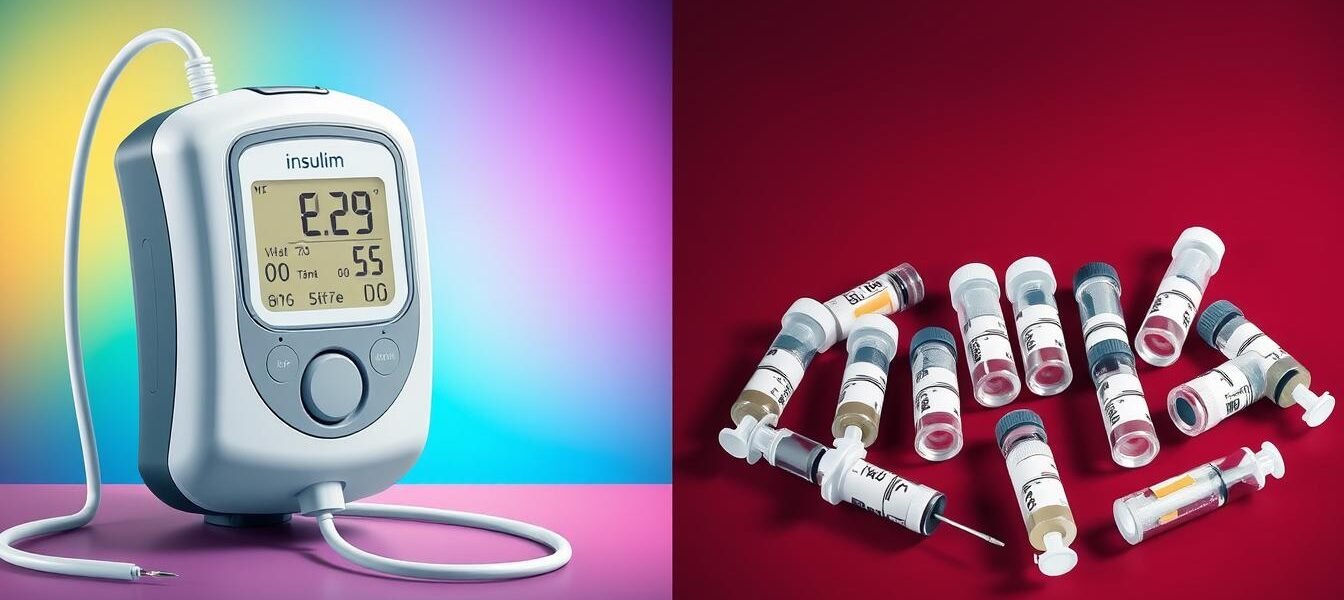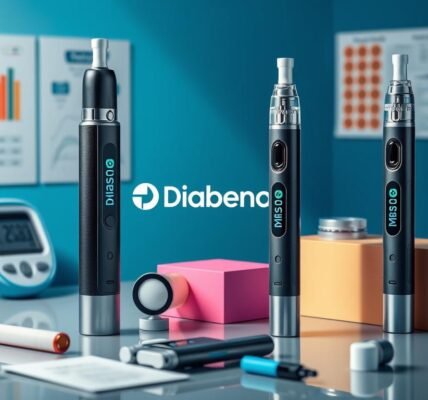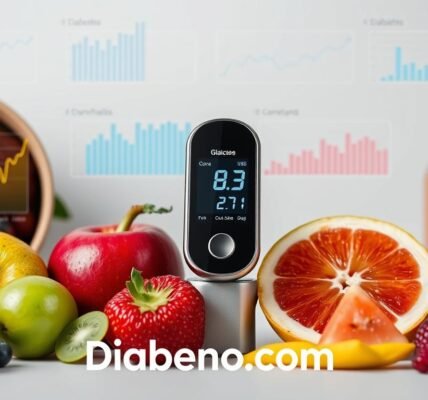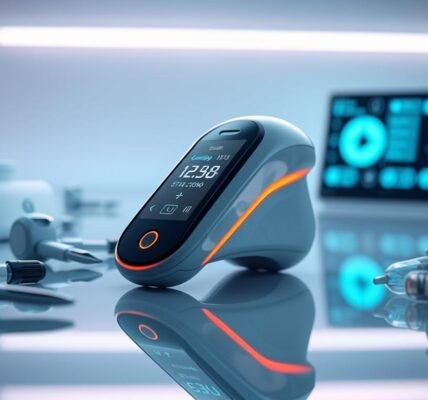Choosing between insulin pumps and daily injections can greatly impact your diabetes care. It’s important to know if insulin pumps are better than traditional injections. Many think daily injections are enough, but new studies show insulin pumps can improve blood sugar control and offer more flexibility.
Research shows insulin pumps can reduce severe low blood sugar episodes by 30% compared to injections1. They also help keep blood sugar levels lower, which can prevent long-term health issues23. When deciding, think about how each method fits into your life. Your choice can affect your daily routine.
Key Takeaways
- Insulin pumps can provide improved blood sugar control compared to daily injections.
- They may lead to fewer episodes of severe hypoglycemia.
- Flexibility in insulin delivery options allows for easier management of lifestyle changes.
- However, insulin pumps can be more expensive and require routine maintenance.
- Consider personal comfort and lifestyle when choosing your diabetes management strategy.
Understanding Diabetes Management
Managing diabetes well means knowing a lot about keeping blood sugar stable. Insulin is key for those with diabetes to stay healthy. It’s also important to check blood sugar often, eat right, and exercise regularly.
Type 1 diabetes means the body doesn’t make insulin. This makes insulin pumps very important for treatment4. Research shows insulin pumps help control diabetes better and reduce the chance of low blood sugar. They give users more freedom to plan meals and activities5.
It’s important to change the infusion set every two to three days to avoid infections5. Continuous Glucose Monitors (CGM) offer insights into blood sugar trends. They help prevent high or low blood sugar5. Some CGM sensors can even warn you or your family about dangerous blood sugar levels5.
Sharing insulin pump data with doctors is crucial. It helps improve your care plan and make changes between visits5. Learning about these aspects helps you make better choices for your diabetes care.
What is Insulin and Why is it Important?
The insulin hormone is key for using glucose, a sugar from carbs, in your body. It helps your cells get glucose for energy. Without enough insulin, your blood sugar levels can get too high, leading to diabetes6.
People with type 1 diabetes often need insulin from outside sources. Those with type 2 diabetes might need different amounts based on their weight and lifestyle. They might use various insulins, like fast-acting and long-acting, to manage their insulin function all day7.
For those with diabetes, the right insulin therapy can prevent serious problems like heart disease and nerve damage. Most insulin is given through injections or shots. But, insulin pumps offer a way for more steady delivery, improving treatment results8.

Types of Insulin Delivery Methods
Choosing the right insulin delivery method is key to managing diabetes well. There are two main options: insulin injections and insulin pumps. Each has its own insulin administration techniques to fit different needs.
Insulin injections can be given with a syringe or an insulin pen. Long-acting insulin is often used once or twice a day, based on your treatment plan. Syringes are affordable, costing about $10-15 for 100 units9. Insulin pens are easier to use but are pricier, with a box of 100 needles costing $20-$709.
Insulin pumps, on the other hand, deliver insulin through a skin catheter. They offer continuous basal doses and bolus doses at meals. This method is more expensive, costing $4,500 to $6,500 without insurance9. Yet, they are very effective for diabetes management9. Some people prefer disposable insulin patches like V-Go for their portability and lack of tubes9.
The choice between these insulin injection alternatives depends on personal preferences, medical history, and lifestyle. With 37 million Americans living with diabetes, finding the right insulin delivery method is vital for effective management10.
The Role of Insulin Pumps in Diabetes Care
Insulin pumps are a key part of diabetes care, offering a new way to manage insulin. They work like the pancreas, sending insulin into your body through a small tube under your skin. This helps keep your blood sugar levels stable, which is important for managing diabetes.
Studies have shown insulin pumps are better than traditional insulin shots. People using pumps had an average blood sugar level of 8.04%, compared to 8.22% for those with shots1. Keeping blood sugar levels low is key to avoiding serious health problems.
Insulin pumps also let you adjust your insulin based on what you eat and how active you are. This means you can handle changes in your life better, thanks to advanced diabetes technology like insulin pumps. This flexibility can make managing diabetes easier and more satisfying.
Adding continuous glucose monitoring (CGM) to insulin pumps makes them even more useful. CGM tracks your blood sugar in real-time, helping you make better choices about insulin. In the U.S., all insulin pumps work well with CGM systems11.
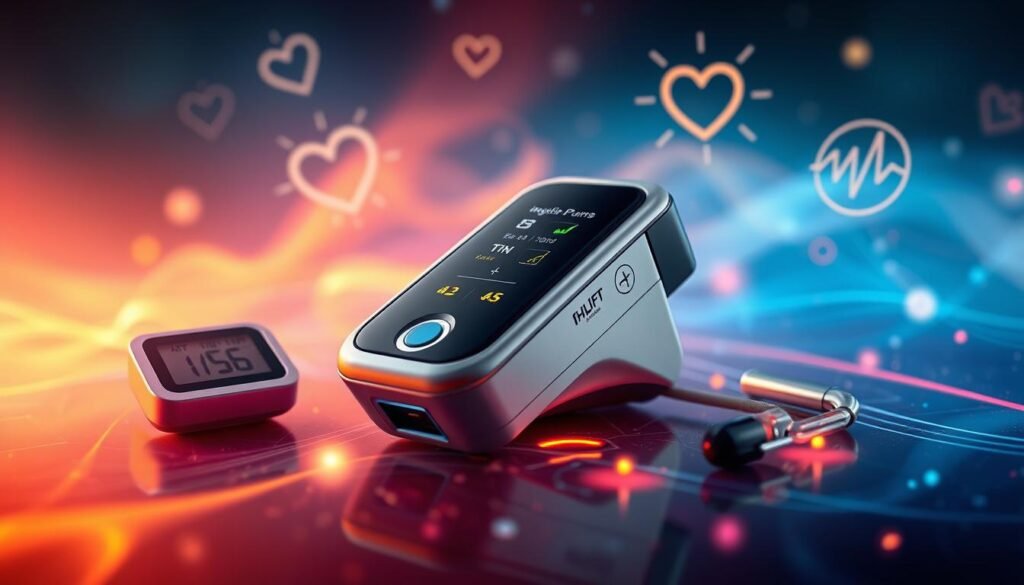
Thinking about how to manage your diabetes? Insulin pump therapy might be a game-changer. It’s in line with the latest in diabetes technology and can help you control your blood sugar better.
Benefits of Insulin Pumps
Insulin pumps help manage diabetes in many ways. They improve blood sugar control, lower the risk of severe low blood sugar, and make it easier to adjust insulin doses. This makes managing diabetes daily more effective and simpler.
Improved Glycemic Control
One big benefit of insulin pumps is better blood sugar control. Studies show insulin pumps can lower hemoglobin A1c levels to 8.04% compared to 8.22% with injections1. NICE research also found insulin pumps lower HbA1c levels in all age groups12.
This better control helps manage blood sugar levels daily. It also helps prevent long-term diabetes complications.
Reduced Risk of Severe Hypoglycemia
Insulin pumps also lower the risk of severe low blood sugar. Research shows insulin pumps have a lower rate of severe hypoglycemia at 9.55 per 100 patient-years compared to injections at 13.97 per 100 patient-years1. NICE found 80% of studies showed a decrease in severe hypoglycemia with insulin pumps12.
This is great for people who might face risks of low blood sugar in their daily lives.
Flexibility in Dosing
Insulin pumps provide flexibility in dosing. You can adjust insulin delivery as needed, especially around meals and exercise. This allows for precise blood sugar management.
By adjusting doses throughout the day, you can better handle changes in food and activity. This is a big plus over traditional injections, which follow a set schedule.
Daily Injections: How They Work
Understanding daily injections is key to managing diabetes well. Patients use syringes or insulin pens for these injections. These injection techniques are easy to use and fit into your daily life. Most people need 8-10 injections a day to keep their blood sugar in check13.
Injection Techniques and Options
There are many ways to give yourself insulin every day. You can choose:
- Syringes – These are traditional tools requiring a vial of insulin.
- Insulin Pens – These devices offer pre-filled cartridges and make dosing simpler and more discreet.
It’s important to use the right technique with syringes or pens for accurate dosing. Long-acting insulin can last up to 24 hours, which means you might need fewer injections14.
Benefits of Daily Injections
One big benefit of insulin injections is how simple they are. They are easy to use, making them great for those who don’t need complicated dosing. You can also adjust your dose based on your daily activities and blood sugar levels. This flexibility is key to managing your diabetes well, as it helps you adjust to changes in your diet and exercise13.
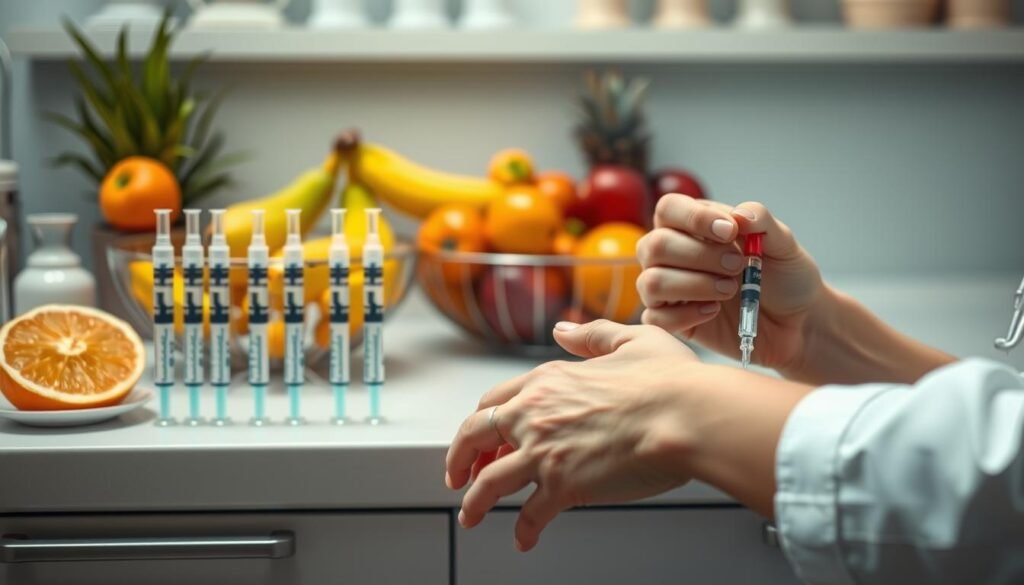
| Injection Method | Typical Usage | Flexibility | Ease of Use |
|---|---|---|---|
| Syringes | 3+ injections daily | Moderate | Standard |
| Insulin Pens | 4-10 injections daily | High | Easy |
Choosing daily injections can make managing your diabetes easier and more focused. If you’re looking into different ways to manage your diabetes, check out a detailed guide here.
“Adapting to daily injections empowers you with control over your diabetes management.”
In conclusion, daily injections are a crucial part of diabetes management. They offer flexibility and essential support to keep your blood sugar stable14.
Insulin Pumps vs Daily Injections
Insulin pumps and daily injections have their own benefits and drawbacks. Research shows that insulin pumps are more accurate in managing blood sugar. This makes them better at keeping blood glucose levels stable. Also, using an insulin pump can lower the risk of severe low blood sugar and improve A1c values21.
Comparative Effectiveness in Blood Sugar Management
Insulin pump therapy offers many advantages. It has a lower rate of severe low blood sugar compared to injections. This shows pumps can help control blood sugar better. Also, pumps use less insulin overall, making them more efficient1.
Patient Lifestyle Considerations
Choosing between insulin pumps and injections depends on lifestyle. Pumps are great for those who don’t like daily injections. However, injections might be cheaper and easier to use11. Pumps are good for those who want precise dosing or have unpredictable lives. But, they might not be right for everyone, especially those with dexterity or sensory issues11.
Advantages of Insulin Pump Therapy
Insulin pump therapy has changed how we manage diabetes. It works well with continuous glucose monitoring systems. These systems give you real-time data on your blood sugar levels. This helps you make better choices about your insulin use.
Continuous Glucose Monitoring Integration
Continuous glucose monitoring is a big step forward in diabetes care. It lets you track your glucose levels all day. Studies show insulin pump therapy helps control blood sugar and lowers the risk of severe low blood sugar.
For teens and kids, using insulin pumps can reduce severe low blood sugar episodes. This is important for their health. It also helps manage blood sugar levels better, which is key for staying healthy.
Customizable Insulin Delivery
Insulin pumps offer customizable insulin delivery. You can set them to give different amounts of insulin based on what you eat and how active you are. This flexibility is a big plus over traditional injections.
Studies show insulin pump therapy can lower HbA1c levels. This is good because it means less risk of long-term diabetes problems. Overall, insulin pump technology makes managing diabetes easier and more effective.
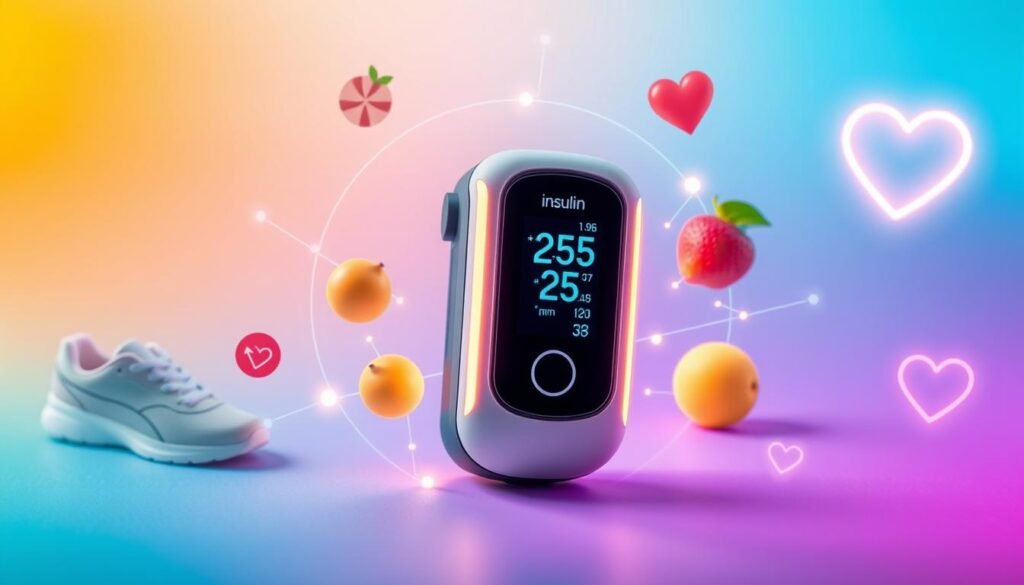
Disadvantages of Daily Injections
Daily insulin injections come with big challenges for people with diabetes. These insulin injection challenges include physical pain and everyday hassles. Knowing these downsides can help you choose better for your diabetes care.
Inconvenience and Pain
One big disadvantage of daily injections is the pain they can cause. Needing to take insulin many times a day can hurt both physically and emotionally. Finding a clean spot for each shot is hard and takes a lot of time.
This routine can mess up your daily life and make diabetes harder to manage.
Potential for Inconsistent Dosing
Another big issue with insulin administration issues is the chance of not getting the right dose. Taking insulin every day means you have to be very careful with timing and amount. If you miss a dose or get it wrong, your blood sugar might not stay in a good range.
This can lead to big swings in blood sugar, which can be dangerous. People often struggle with these insulin injection challenges, making it tough to keep their diabetes under control.
Considerations When Choosing Insulin Delivery Methods
Choosing the right insulin delivery method is key to managing diabetes well. You need to think about your lifestyle and the costs of different options. Knowing these can help you pick a method that improves your life.
Patient Lifestyle and Preferences
Your personal choices and preferences are important when picking between insulin pumps and injections. Insurance plays a big role in this choice, affecting your access to supplies and support15. Many people find insulin pumps better for controlling blood sugar, especially for those who struggle16.
Insulin pumps offer precise dosing, helping to keep A1C levels stable, often around 5% for good management15. Healthcare providers often let you try different systems to see what works best for you15.
Cost and Accessibility Factors
Cost is a big factor in choosing insulin delivery methods. Insulin pumps are pricier than injections, with costs for the pump and supplies like infusion sets and reservoirs16. Insurance might cover pumps in some cases, making them more accessible for many16.
Considering these costs and the benefits of better blood sugar control with pumps can help you make a better choice16.
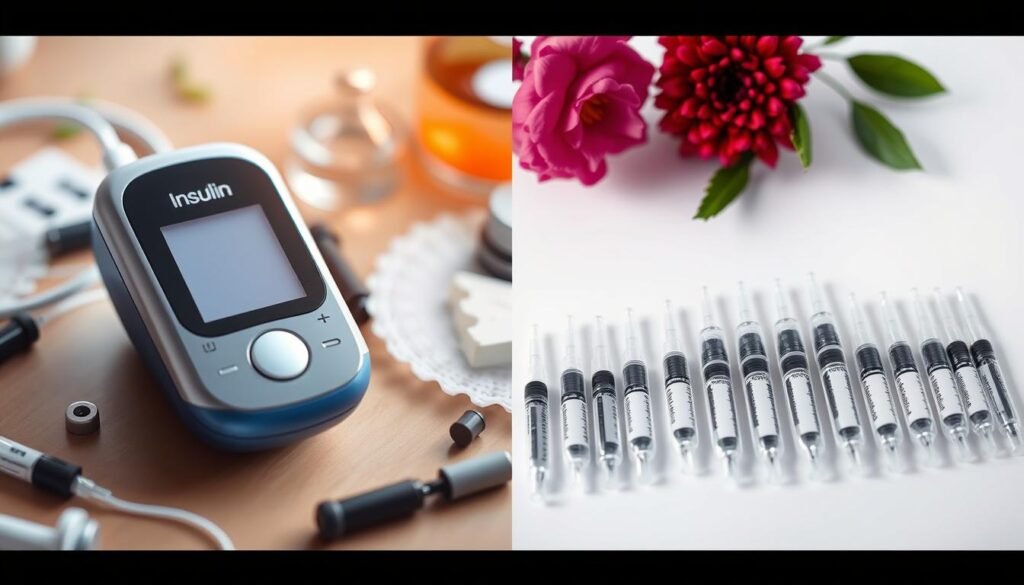
| Insulin Delivery Method | Advantages | Disadvantages | Cost (approximate) |
|---|---|---|---|
| Insulin Pumps | Better glycemic control, convenience, customizable delivery | Higher cost, training required, risk of infection | Higher; includes maintenance and supplies |
| Daily Injections | Lower cost, simple to administer | Multiple injections required, risk of inconsistent dosing | Lower; costs mainly from insulin |
Learning and Adaptation Period for Insulin Pumps
Starting with insulin pumps needs a learning and adaptation phase. This begins with training for insulin pump users. It’s key to get the hang of the tech and manage insulin well. There are many resources to help, like training sessions, videos, and detailed guides in user manuals.
Training and Support for New Users
Getting the first training is crucial. It teaches you about the pump’s features and how it works. Healthcare providers offer one-on-one coaching, giving personalized tips. Also, manufacturers have hotlines and forums for questions and sharing experiences.
Using these resources makes learning insulin pump management easier.
Managing Pump Technology
Getting used to the pump’s tech can be tough. You need to check it regularly, like watching insulin delivery and alarm checks. Knowing how to fix common issues is also key. This helps you manage diabetes better and keep blood sugar stable.
https://www.youtube.com/watch?v=22gTTK_0szg&pp=ygUJI3BlbnNwdW1w
Comparison of Clinical Outcomes
Studies have shown that insulin pump therapy and daily injections have different effects. People using insulin pumps often have better blood sugar control. This section looks at how these methods compare, especially in terms of hypoglycemia and ketoacidosis rates.
Research Findings on Hypoglycemia and Ketoacidosis Rates
A study with 362 Type 1 Diabetes patients found that insulin pump users had a lower HbA1c level. Their average was 8.1% compared to 8.7% for those using daily injections17. The fasting C-peptide levels were also lower in the pump group, averaging 43.0 pmol/L against 68.3 pmol/L for injections17.
More insulin pump users reached an HbA1c level below 7.5%, with 52.5% achieving this goal. Only 32.9% of daily injection users reached this level17. The mean blood glucose level was also lower in the pump group, at 8.3 mmol/L compared to 9.4 mmol/L for injections17.
Another study with 21 Type 2 Diabetes patients found that insulin pumps and daily injections had similar results. Both methods showed no adverse cardiovascular effects18. While glucose variability improved in both groups, there were no significant differences between the methods18.

How to Transition from Daily Injections to an Insulin Pump
Switching to an insulin pump needs careful thought and planning. Start by talking to your healthcare team to see if a pump is right for you. A chat with your endocrinologist can clear up any doubts and set clear goals for the change.
It’s important to understand how insulin pumps work. They give insulin in two ways: a steady basal rate and bolus doses for meals. Learn about the different insulin pumps and their features. Each one works a bit differently.
Getting used to a pump means adjusting your daily routine. You might need to learn new skills to use the pump right. Start practicing with the pump while still using injections to feel ready for the switch.
Staying committed and consistent is key during this time. Keep an eye on your blood sugar levels closely, especially when starting with the pump. Talking regularly with your healthcare provider helps make any needed changes to your insulin doses.
Also, learn about how to store and handle insulin. Keeping insulin at the right temperature is crucial for it to work well. This ensures you get the most out of your pump therapy.
| Consideration | Details |
|---|---|
| Healthcare Discussion | Engage with your endocrinologist to determine suitability for pump therapy. |
| Technology Familiarization | Understand the functions and features of different insulin pumps. |
| Routine Adjustments | Prepare for changes in daily management and monitoring techniques. |
| Commitment | Maintain regular blood glucose monitoring and follow-up appointments. |
| Insulin Handling | Store insulin at recommended temperatures to ensure effectiveness. |
Make the switch to an insulin pump easier by staying informed and confident. This will help you manage your diabetes better11911.
Patient Experiences: Real-Life Testimonials
Learning about patient experiences with insulin pumps offers valuable insights into diabetes care. Many have shared how insulin therapy has changed their lives. For instance, those with Type 1 diabetes saw their blood sugar levels drop from 12.3% to 5.8% after starting insulin pumps20. These stories show how insulin pumps can greatly improve health and life quality.
A study with 18 adults switching from injections to insulin pumps showed big benefits. They enjoyed better health and more freedom in their lives. They also had fewer blood sugar swings and hospital visits21. Plus, they felt happier and more confident in managing their diabetes.
Users of the MiniMed™ 780G system, which combines insulin pump therapy with SmartGuard™ technology, have had positive experiences. This system helps those aged seven and up manage their blood sugar better22. They liked the alerts from their pumps, which helped avoid blood sugar extremes.
| Criteria | MDI | Insulin Pumps (CSII) |
|---|---|---|
| A1c Levels | Up to 12.3% | As low as 5.8% |
| Blood Glucose Variability | High | Lower |
| Hospital Admissions | Higher | Fewer |
| Nighttime Awakening | Frequent | Less Frequent |
These stories highlight how insulin pumps can change lives for the better. They show that insulin therapy not only improves health but also daily life for many.

Conclusion
In this insulin management review, we’ve seen that insulin pumps and daily injections are both key in diabetes care. Each has its own benefits and challenges, fitting different patient needs and likes. For example, insulin pump users saw a big drop in HbA1c levels, by 0.6% over seven years23. They also had fewer severe hypoglycemia events, from 14.7 to 7.2 per 100 patient-years.
Daily injections also offer good options for insulin delivery. As diabetes cases are expected to skyrocket, knowing about these treatments is vital24. It’s important to consider your lifestyle, what you prefer, and your doctor’s advice when choosing between pumps and injections.
Both methods have shown they can work well. But, involving yourself in this choice can lead to better diabetes management in the long run.
Your choice of insulin therapy should match your personal needs and health goals. Whether you like the ease of a pump or the straightforwardness of injections, your diabetes care should stay top-notch.
FAQ
Are insulin pumps more effective than daily injections for managing blood sugar levels?
What are the main benefits of using insulin pumps?
What are common techniques for daily insulin injections?
How do insulin pumps work?
Are there any downsides to daily injections?
What factors should I consider when choosing an insulin delivery method?
How do continuous glucose monitoring systems work with insulin pumps?
Is there a learning curve associated with using an insulin pump?
Can transitioning from daily injections to an insulin pump be beneficial?
What patient experiences are commonly shared about insulin pumps?
Source Links
- https://pmc.ncbi.nlm.nih.gov/articles/PMC5818842/
- https://www.rainier-research.com/blog/insulin-pumps-vs-insulin-injections-which-is-right-for-you
- https://myhealth.alberta.ca/Health/pages/conditions.aspx?hwid=zx1815
- https://centerforfamilymedicine.com/diabetes/diabetes-cares-benefits-of-insulin-pump-vs-injections/
- https://www.umassmed.edu/dcoe/diabetes-education/pumps_and_cgm/
- https://www.uptodate.com/contents/type-1-diabetes-insulin-treatment-beyond-the-basics/print
- https://www.mayoclinic.org/diseases-conditions/diabetes/in-depth/diabetes-treatment/art-20044084
- https://evidence.nihr.ac.uk/alert/insulin-pumps-not-much-better-than-multiple-injections-for-intensive-control-of-type-1-diabetes/
- https://beyondtype2.org/insulin-delivery-methods/
- https://www.anthem.com/dam/medpolicies/abc/active/guidelines/gl_pw_e002723.html
- https://my.clevelandclinic.org/health/articles/insulin-pumps
- https://www.diabetes.co.uk/insulin-pumps/pros-cons-of-insulin-pumps.html
- https://www.medtronicdiabetes.com/loop-blog/day-life-mdi-vs-insulin-pump-therapy-cgm
- https://www.ceceliahealth.com/managing-glucose-levels-the-pros-and-cons-of-insulin-pumps-vs-injections/
- https://www.yourdiabetesinsider.com/blog/insulin-pump-vs-multiple-daily-injections-choosing-the-right-approach-for-diabetes-management
- https://gluroo.com/blog/diabetes-101/pros-cons-insulin-pumps-children/
- https://www.frontiersin.org/journals/public-health/articles/10.3389/fpubh.2022.990281/full
- https://link.springer.com/article/10.1007/s12020-023-03651-w
- https://www.fda.gov/drugs/emergency-preparedness-drugs/information-regarding-insulin-storage-and-switching-between-products-emergency
- https://www.umassmed.edu/dcoe/diabetes-care/success-stories/
- https://pmc.ncbi.nlm.nih.gov/articles/PMC7315212/
- https://www.medtronicdiabetes.com/diabetes-real-life-stories
- https://link.springer.com/article/10.1007/s00125-013-3007-9
- https://www.mdpi.com/1648-9144/59/1/141
